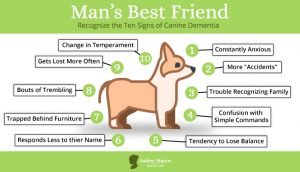We all know that there are some great methods of providing excellent caregiving for someone with dementia or Alzheimer’s, but what happens when man’s best friend starts showing signs of dementia? Dementia and dogs are seldom understood by pet owners, but the condition known as Canine Cognitive Dysfunction (CCD) is real and can certainly be a major issue.
Because of its seriousness, it’s crucial that dog owners notice the signs of dementia as they appear in your pet. It’s important to understand that it can be harder to notice this condition because a dog doesn’t communicate in the same ways that a person suffering from dementia and Alzheimer’s would, so it’s easy to miss the telltale signs of CCD. Similarly to human Alzheimer’s, CCD is caused by the buildup of plaque in a dog’s brain. This plaque damages nerves and can start to limit your dog’s brain function.
In this guide, we’re going to walk you through the ten most important signs of canine dementia so that you can get your furry buddy the help that he or she needs.

Sign One: Your Dog is Constantly Anxious
Like humans that are suffering from dementia, dogs will start to be a bit anxious in everyday situations. This is a result of a near-persistent state of confusion that causes high degrees of anxiety. It’s important to understand that the effects of dementia and dogs are similar to the effects of the disease in humans; confusion in everyday environments is scary and the effects of the disease will make it hard for your dog to understand what’s happening.
Sign Two: There Are More “Accidents”
It’s amazing; one of the first things that your dog has learned may also be one of the first things to go when CCD strikes. Simply put, your old dog may simply forget that he or she needs to go outside to relieve themselves. While there are other conditions that might make an older dog do their business indoors, this change in behavior can also be a symptom of canine cognitive dysfunction.
When CCD is taking hold, then your dog may not even be aware that what they are doing is wrong; they simply think that when nature calls, it’s time to find a place to answer the call. In this situation, you may find that there is a specific place that they may go to void around the house. When this happens, seek out a veterinarian.
Sign Three: Your Dog is Starting to Have Trouble Recognizing Family Members
One of the best features of having a canine buddy is the fact that they love to meet you at the door when you come in from work. Dogs love to see us, so when we come through the door, it’s the highlight of their day. Unfortunately, when a dog starts to be affected by cognitive dysfunction, they won’t be as receptive of human companionship. In fact, they may even feel the need to actually hide when you come home from work.
This lack of recognition can be another scary aspect of dementia in your dog. The very people that once comforted and excited your dog will now frighten him or her to the point where they may not even wish to be petted by family members. When this happens, you’ll need to try to strengthen the canine-human bond. It may feel like you’re helping your pet get to know the family again, but it can help alleviate your dog’s anxiety.
Sign Four: Confusion with Simple Commands Seems to Happen More Often
Have you noticed that your dog seems confused even with simple commands like “sit?” While this can be a result of hearing loss, which is common in geriatric canines, it could also mean that it’s a symptom of cognitive dysfunction. Simply put, as a result of the formation of plaque on the neurons, your dog might not be able to process the command as well as when they were a younger dog.
This can be similar to what’s experienced in elderly humans. During this stage, you’ll simply have to be more patient and understanding with your pet.
Sign Five: There’s a Sudden Tendency to Lose Balance
Disorientation is a sure sign of CCD. When you notice that your dog stares at walls, gets lost or stuck in corners, or simply has a new habit of simply falling down, then canine dementia can be the cause. While this is definitely a symptom that occurs in humans, it can be pretty severe in dogs but not as noticeable. Sometimes, this reduced sense of balance won’t necessarily cause your dog to fall down, but it will cause him or her to stumble. Also, if your dog is falling off the bed, it could be because their sense of balance is being attacked by CCD.
Sign Six: Your Dog Seems to Be Responding Less to His or Her Name
When you call your dog by his or her name, does he or she refuse to look at you? This could actually be a sign that your dog is having trouble remembering his or her name. This is where the condition can differ significantly from human dementias like Alzheimer’s; while a person with dementia can experience a loss of memory that can cause them to forget family member’s names and faces, it’s very rare for a person suffering from the condition to forget their own.
Sign Seven: Getting Trapped Behind or Under Furniture
This is one of the behaviors that have no analog when humans suffer from dementia. As a result of the confused state that CCD can cause, your pet might try to hide a lot more as we mentioned before. This can lead to your dog getting stuck under or behind furniture. This is because he or she might go there to hide but might then forget how to get out of their hiding spot later on.
When starts to happen, it’s imperative that you try to make your home as friendly to your dog’s needs as possible. Ideally, you want to create a home environment where your dog will feel safe and won’t need to hide. You can ask your veterinarian for ideas, but typically, it just means making smaller spaces where your dog can get stuck less accessible. Simply put, just try to create wide pathways in your home for your dog to use.
Sign Eight: Your Dog Has Sudden Bouts of Trembling
In humans, shaking and Parkinson’s-like symptoms are clear indicators of Lewy Body Dementia, which is also known as LBD. In dogs that are experiencing canine cognitive dysfunction, shaking can be a fairly regular occurrence. Unlike in humans, this trembling doesn’t necessarily have anything to do with the formation of protein-based Lewy bodies. In fact, this trembling can just be a side effect of the heightened anxiety that has been caused the confusion that accompanies the onset of dementia in your dog.
When this trembling happens, it may be difficult to comfort you dog, especially considering that it may be a result of the high-stress levels of not knowing what’s happening. The best way to calm them is to be gentle and involved and gradually make them feel more at ease.
Sign Nine: Your Dog Seems to Get Lost More Often
As you know by now, this condition is very confusing for canines. You may notice that your dog will not quite know their way, even on paths that they’ve walked for years. In fact, you may even find that your dog may get lost inside the confines of your home. When this happens, canine dementia may be the cause. It’s important to simply be supportive and guide your dog; at this stage, it’ll help them be happier knowing that you’re there to guide them.
Sign Ten: There’s a Change in Temperament
Has your typically placid dog started to become more aggressive? Has your typically inquisitive dog become much more withdrawn and fearful? Just like with people, both of these are signs of dementia. Sometimes, as a result of this condition, your dog may behave uncharacteristically; they may suddenly become angry, bark at nothing, and start interacting less with family members and other pets. When this happens, you can seek a consultation with a veterinary behaviorist in order to find out the best steps to manage the behavioral changes in your pet.
Similarly to humans, there are ways to help your pet deal with the changes that dementia can bring to their lives. Keep them active, consult with a veterinary behaviorist, and consult with your vet about CCD-managing drugs like Anipryl. Age is inevitable, and the challenges of age will come to us all, and while your dog will struggle, simply show him or her love and support and your bond will help them through it.



Leave a Reply